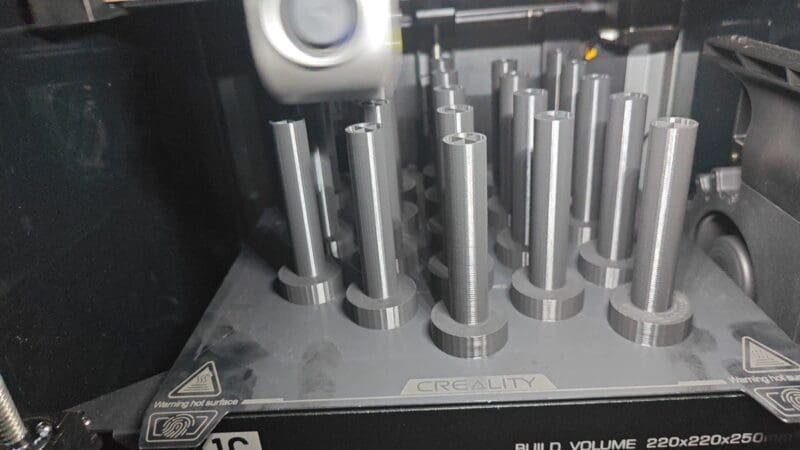Creality Ender 3 v3 review: Worth it or not?

The Ender-3 V3 represents a groundbreaking step for Creality. Typically, most printers on the market feature the i3 COREXY structures, but this Ender 3 v3 introduces the CORE XZ structure. This might sound a bit technical to newcomers, so let’s break it down.
In the i3 setups, each axis (XYZ) operates independently with its motor, which means straightforward movement control. The Core XY design complicates things a bit, with two motors managing the XY axes through a shared belt system, and a separate motor for the Z axis. The CORE XZ configuration that the Ender-3 V3 uses involves a similar dual-motor approach but applies it to the X and Z axes.
This setup not only makes the gantry complex but also aesthetically sleek, unlike the slightly messier I3. However, it’s worth noting that the Y axis can still carry quite a bit of inertia.
In an interesting shift, Creality has opted to ditch the old wheel and rail system in favor of a belt-driven Z-axis. This modification could potentially transform the printing experience and the quality of the outcomes. We’ll dive into some initial print tests to see how these adjustments play out in practice.
Unbox

Unboxing the Ender-3 V3, here’s what you find right out of the box: a surprisingly thick manual, a warranty card, a Teflon tube, various clips, a filament spool holder, a touchscreen, a cleaning needle for after-use, a set of wrenches, zip ties, a water pump plier, a tube of rail grease, and a USB stick with resources.
The packaging is impressively sturdy, utilizing thick foam and a gantry frame for protection. My favorite feature is the machine’s integrated sheet metal structure and the power cord. The entire base of the printer is made from a sheet metal frame, making it exceptionally robust. The finish is also top-notch, with rounded corners and a metal cover plate on the bottom, all sitting on large anti-vibration pads.

These details highlight significant aesthetic upgrades in the V3, setting it apart from the Ender-3 series. On the left side of the base, you’ll find the power supply’s voltage fluctuation switch. Mounting the gantry onto the base is a breeze due to the high precision of the connecting parts, fitting together seamlessly without the need for manual support as was necessary with previous models.
Removing the protective film on the front, you use eight M48 screws, all designated for securing the gantry to the base. The screws are distributed with two on the left, two on the right, and another pair on the bottom, all easily managed with power tools for convenience.
Setting up
Setting up the Ender-3 V3 begins with checking the voltage. Before assembling, note that fitting the gantry can be tricky; you might need to lift the X-axis to slide it into place properly. Once positioned, secure it by tightening two screws on the side and two additional screws underneath. The base is supported by four shock-absorbing rubber pads, enhancing stability.
Next, take out the wiring and connect the screen, peeling off the protective film. Fit the filament spool holder onto the side of the gantry, following the arrow markers to correctly connect the wires. Use zip ties to secure the extruder’s wiring, then cover it with a small cap, ensuring the wires are angled to avoid touching the top of the gantry. Now, use clips to fix everything in place, so the wires neatly exit from the back. This setup also includes the power supply and switch.

Before starting the printer, check the tension and smoothness of the belts on each axis. The printer uses an automatic tensioning system, so adjustments are typically unnecessary.

This is a direct drive extruder, and you can unscrew two screws on the front cover to remove it if necessary. The nozzle’s maximum temperature is officially 300 degrees Celsius, and the heat bed can reach up to 110 degrees.

Upon powering up, you’ll notice a logo lighting up on the extruder, adding a refined touch. The system is based on Klipper, which means it boots up similarly—and somewhat slowly.
The screen is a capacitive touchscreen, capable of connecting to WiFi for wireless printing. The machine will guide you through an automatic self-test, which is crucial to check. It undergoes an automatic resonance compensation process, which can be noisy but is vital for high-speed printing.
Finally, the bed leveling is also automated, requiring no manual input from the user. Just sit back and wait without worrying about manual adjustments.
design and features
Now, let’s delve into the design and features of this machine. The overall sheet metal frame is what I appreciate the most, marking a significant departure from previous models with profiles or plastic casings. The metal frame not only enhances the machine’s texture and durability but also improves its stability.

The base design is remarkably clean and compact, taking up even less floor space than the previous Ender 3 V3 Ke, excluding the outward-extending filament holder. The Y-axis employs two 10mm smooth rods and a belt drive, maintaining the same 220×220 mm print area as Creality’s K1C, featuring a gold-layered print bed with two handles at the front, two alignment slots at the back, and two screws for rapid positioning at the rear of the bed. The opposite side is a smooth panel.
The screen at the forefront is the same model used in the K1C, a capacitive touchscreen that has received positive reviews. The rear of the machine includes a row of cooling vents, the power socket, and the power switch.
The wiring for the heated bed is notably robust, and the extruder’s cables are also thicker and more durable than standard, enhancing reliability. With the addition of a filament runout sensor, extra protection is provided by cable sleeves, including clips for the wires and nozzle, all with precision design.
The gantry of the machine is perhaps its most intriguing part. There are two motors at the base, placed horizontally, each with a drive belt. These belts pass through the X-axis, travel up to the top in a crossover pattern, then return to the X-axis and back down to the motors. This configuration might seem complex, but it effectively combines the X and Z axes into what we call the CORE XZ structure.
The stability and performance of such a setup can only be truly assessed through practical printing tests. The CORE XZ structure means that belts drive both sides of the X-axis, and with two additional 10mm smooth rods, the machine utilizes a total of six smooth rods, all belt-driven.
This machine was a long time in the making before its launch, suggesting that Creality’s engineers spent considerable time optimizing and improving it. The delay in its release likely indicates the high level of importance and expectation placed on this model by its creators. Personally, I hope that it performs excellently and carves out a significant niche within the i3 printer category.
Print Test

Now let’s begin the print test. First, we’ll print a benchmark test boat. The printer has only one USB port, so let’s check if the test boat file is included; if it is, we can start printing directly. I’m guessing this will be at the manufacturer’s highest recommended speed.

The noise level is approximately 50 to 60 decibels. The official maximum speed is an impressive 600mm/s, much faster than previous Ender series models, with a declared maximum acceleration of 20,000mm/s. The print area is 220×220 mm, with a height of 250 mm. The test boat file included on the USB stick is set with sparse infill, completing the print in just 13 minutes.

Let’s examine the results. The sides of the boat show no obvious layer misalignment, although it appears to have been printed with a layer height of 0.25 mm. Considering the high speed, the sides are acceptable, but the deck and top show some flaws, likely due to the high speed.



This brings us to a choice between speed and quality: which do we prioritize?
I prefer quality, so I sliced another boat model myself, this time with a 0.2 mm layer height at a speed of 300 mm/s, estimating a print time of over 40 minutes. I sent the file to print wirelessly, and set up a time-lapse recording on my phone. Creality also offers a compatible monitoring camera for remote monitoring and time-lapse photography.
The print finished in 46 minutes—this is what a boat looks like when printed at 300 mm/s. Comparing the 13-minute and 46-minute prints, the difference is stark, not just in color but notably in quality. The sides of both are decent, but there’s a clear difference in the quality of the deck and top surfaces, with the slower 300 mm/s print yielding much higher quality.



So, it really depends on your needs. High-speed printing at this quality level is acceptable, but if you seek finer details, I recommend printing at slower speeds.

Conclusion
That wraps up our unboxing and initial hands-on experience with Creality’s Ender 3 V3. Summarizing the innovative coreXZ structure, it represents a bold attempt and a significant breakthrough. After a long period of quiet development, Creality has finally showcased its distinctiveness, which is certainly commendable.
The extruder, shared with the K1C, has undergone several iterations and has stabilized. The flagship machine’s capacitive touchscreen has also been adapted to the i3 model. Of course, my personal favorite feature is the V3’s sheet metal frame structure. Whether it’s the craftsmanship, the tactile quality, or the aesthetic design, this machine really aligns with my tastes.
From my initial impressions, this machine is poised to become a strong competitor within the i3 series. However, how it performs with large models and in long-term fatigue tests remains to be seen. Will it meet my expectations? Stay tuned for a more in-depth review report in the future.
Where can I buy Creality Ender 3 V3?

DISCLOSURE: THIS POST MAY CONTAIN AFFILIATE LINKS, MEANING I GET A COMMISSION IF you DECIDE TO MAKE A PURCHASE THROUGH MY LINKS, AT NO COST TO YOU. PLEASE READ MY DISCLOSURE FOR MORE INFO.



